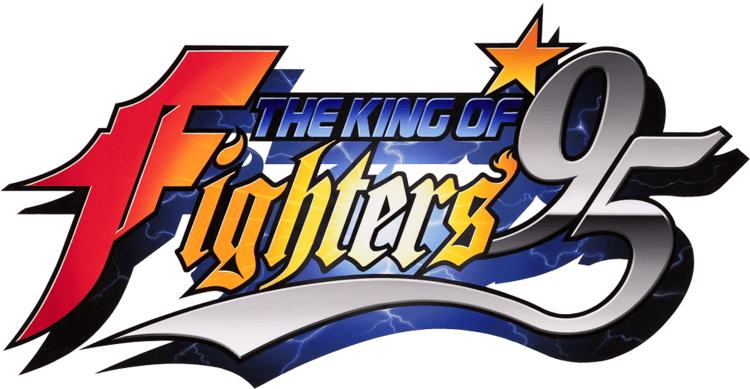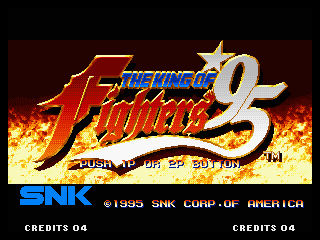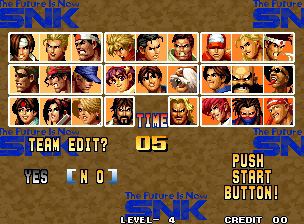9.4 /10 1 Votes9.4
Director(s) Masanori Kuwasashi Cabinet Upright Initial release date 25 July 1995 | 4.7/5 CoolROM Mode(s) One or two players Arcade system Neo Geo | |||||||||||||||||||||||||||||||||
Producer(s) Takashi NishiyamaEikichi Kawasaki (executive) Composer(s) Papaya (Masahiko Hataya) Platforms Arcade game, Neo Geo, PlayStation, PlayStation 3, PlayStation Portable, Sega Saturn, Game Boy, Wii, Neo Geo CD Similar The King of Fighters games, SNK games, Fighting games | ||||||||||||||||||||||||||||||||||
The King of Fighters '95 is a 1995 fighting game produced by SNK for the Neo Geo arcade and home console. It is the sequel to The King of Fighters '94 and the second game in The King of Fighters series. It is also the first game in the series to be ported to other home consoles besides the Neo Geo AES and Neo-Geo CD, with versions released for the PlayStation, Sega Saturn and Game Boy. It was also rereleased in The King of Fighters Collection: The Orochi Saga in 2008 for the PlayStation 2, PlayStation Portable and Wii.
Contents

The game features a similar cast to KOF '94 with the exception of the USA Team, which was replaced by the Rival Team. The plot features a new King of Fighters tournament once again promoted by the criminal Rugal Bernstein, who wants to take revenge against Kyo Kusanagi, who defeated him in last year's tournament. The game also introduces a sub-boss character, Saisyu Kusanagi, who is the father of Kyo. KOF '95 also introduces the fighter Iori Yagami, who becomes Kyo's rival in the series.

One of the main focuses in the creation of The King of Fighters '95 was the introduction of the Rivals Team, most notably Iori, who became one of the favorite characters from the staff. The game has received mixed reviews from various video games publications. Most writers have complained about the response from controls and long loading times from the PlayStation port. However, the introduction from the enhanced version of Rugal, Omega Rugal, as well as the differences between all the characters have been noted to be one of the best parts from the game.

Gameplay

The gameplay and rules are mostly unchanged from The King of Fighters '94. The main addition is the introduction of the Team Edit feature, allowing the player to create a custom team from any of the game's twenty-four characters in addition to the pre-defined teams in the game. Through the main play mode, players must defeat all of the teams from the game in order to fight the bosses: the brainwashed Saisyu Kusanagi, followed by a stronger Rugal Bernstein.
Plot and characters
The King of Fighters '95 marks the beginning of a story arc that later became known as the "Orochi Saga". However, the only elements from the Orochi Saga known in this game is the introduction of Kyo's rival, Iori Yagami, and Rugal's use of the Orochi power.
Rugal Bernstein, thought to have perished in an explosion in the previous game, had in fact survived and sent out invitations to the teams from the previous game signed simply ‘R'. Only one of the previous teams failed to attend the new tournament: the American Sports Team, now replaced by the "Rival Team" consisting of Iori Yagami, Billy Kane (from Fatal Fury: King of Fighters), and Eiji Kisaragi (from Art of Fighting 2). Saisyu Kusanagi, Kyo's father, appears as a fighter for the first time (having made a non-playable cameo in KOF '94) as a computer-controlled sub-boss character. After defeating Saisyu in the arcade mode, it is revealed that Saisyu was being brainwashed and that Rugal will fight once again as a boss character, but as an enhanced version named "Omega Rugal".
Development
The KOF '95 project began with the concept of introducing Iori Yagami as Kyo Kusanagi's rival. As such, developers gave him traits to expand that relationship such as similar abilities and ancient rivalry between both of their clans. During the initial location tests to determine the popularity of the game, Iori was the character who stood out most, also becoming a favorite of the developers. The creation of the Rival Team was one of the things developers worked the hardest, focusing in their moves and lines. The character of Eiji Kisaragi was originally from Art of Fighting 2 and the staff had to adjust most of his moves to balance him with the other characters. Following this game, several Art of Fighting characters were removed from each sequel with developers saying it was "thanks to KOF jinx." The sub-boss character, Saisyu Kusanagi, was never meant to appear in the game as the staff wanted to make so that he died in The King of Fighters '94 during one of the cut-scenes from the Hero Team. However, Saisyu was added at the last moment to the game, becoming the sub-boss character. Fatal Fury boss character Geese Howard was meant to be playable in the game; various considerations at the time, however, led developers to abandon this plan.
The King of Fighters '95 was one of the first titles from SNK to be ported to the Sony PlayStation system. Chad Okada, a former member from SNK, mentioned it was one of his first works. He commented that he had to improve its marketability to the North American market. As a result, he added new options to the game that were not present in the original Japanese version such as selection from stages and improve the grammar and spelling, which was one of the biggest issues from the Neo Geo version.
Release
The original Japanese arcade version was released on July 25, 1995 and it was ported to the Neo Geo and Neo-Geo CD later that year. A port of the Neo Geo release was added to Wii's Virtual Console service on April 26, 2010. It is slightly edited, however; the blood is removed and Mai lacks her signature bounce, both in her fighting stance and win animation. Both of these aspects can be activated with a code, however.
In 1996, the game was ported to the PlayStation and Sega Saturn. The PlayStation version was published on August 31, 1996 in North America and the PAL region by Sony Computer Entertainment Inc.. It featured a remixed soundtrack which took advantage of the Redbook audio format. The Saturn version (which required a ROM cartridge that came packaged with the game disc) was also released in Europe by Sega. The bundled ROM cartridge contains the majority of the character animations. It was the first video game to use a CD-ROM and a ROM cartridge in tandem. The "Playstation the Best" version was also re-released on March 28, 1997. It was also compiled in The King of Fighters Collection: The Orochi Saga in 2008 for the PlayStation 2, PlayStation Portable and Wii.
A Game Boy game based on The King of Fighters '95 (Nettō The King of Fighters '95 in Japan) was published by Takara in Japan and by Nintendo in North America. It featured compatibility with the Super Game Boy, as well as introducing Nakoruru from the Samurai Shodown series as a secret character.
Related media
The game received a variety of licensed media released in Japan in 1994–1995:
Reception
The King of Fighters '95 was awarded Best Neo-Geo Game of 1995 by Electronic Gaming Monthly in 1996. During its release week, the Sega Saturn port of the game sold 135,214 copies in Japan. As of 2004, the game remained with 257,294 copies sold. The PlayStation port had an average of 68.60% based on five reviews collected by GameRankings. The Neo Geo and Game Boy versions received a 78.75% and a 62.00%, respectively, based on only one review.
The four reviewers of Electronic Gaming Monthly declared the Neo Geo AES version a solid improvement over the previous King of Fighters, particularly applauding the addition of the team edit feature. Major Mike of GamePro agreed that this was the game's best feature, but also expressed approval for the replacement of the U.S. team with the new "Rival" team and the control modifications. He did criticize that the game "didn't improve '94's graphics, it just added to them", but concluded King of Fighters '95 to be "one of the best brawlers out there". A reviewer for Next Generation was unimpressed, however, remarking that "The idea behind fighting as a three-person team ... adds an interesting flare to the game, but the final result is still a one-on-one fighting game with nothing much new to offer the seasoned fighter."
Reviewing the Neo Geo CD version, Maximum deemed that "SNK remain masters of the sprite-based one-on-one fighting genre, leaving all competitors way behind with King of Fighters '95." They elaborated that the team combat makes for greater variety than the average fighting game, the team edit feature greatly increases the game's enjoyability and longevity, the unusually high difficulty of executing combos makes pulling them off more satisfying, and the animations are greatly improved from The King of Fighters '94.
The PlayStation version, however, was much less well received, as reviewers stated it has a poor design in comparison to other fighting games from the same year. IGN gave a 5.0/10 to the PlayStation version, criticizing that the characters are not very responsive to controls and "even though these are difficult hurdles to jump, they're not impossible". However, they noted it to be a likeable game, saying it has "that 2D anime look that everyone loves". Jeff Gerstmann from GameSpot gave it a 5.3/10. He also criticized the long loading times from the PlayStation version as well as how frequent they are since every round requires loading time. The Sega Saturn version had no loading time thanks to the ROM cartridge that came with the game. Game Revolution gave it a C+, noting the game to be very entertaining but it still was not as good as other fighting games from the year it was released in North America. However, they criticized that the fighting system is very similar to other SNK games such as Fatal Fury and Art of Fighting. 1UP.com praised the introduction of Omega Rugal, noting him to be "one of the most stylish boss designs in fighting history", although players could hate him due to how difficult it is to defeat him.
IGN commented that the characters' designs and abilities are very similar to the ones from Street Fighter Alpha. Jeff Gerstmann complained that the characters have unattractive moves as well and over pixelated sprites. 1UP.com praised SNK's characters designs and the addition of the team edit option, making the game a good competition for Street Fighter Alpha. However, Game Revolution liked the large number of playable characters and the several options featured in the game such as the team fights and special moves.
